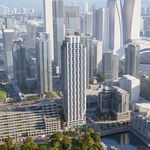TheTigerMaster
Superstar
I would say the problems with this project reflect problems at every level - federal, provincial and municipal.
That said, a return to a Metro form of municipal government and less provincial interference in planning would yield better results.
We wisely have a separation of church and state - there should also be some level of separation between transit planning and state.
@syn I agree that a return to the Metro government would be best. However this would have to be coupled with Metro having the revenue tools necessary to implement their plans.When Metro initially opted to build an LRT over the surface subway to connect STC to Kennedy, it was due to cost savings. Personally I would have favoured the more expensive surface subway, but the LRT plan was justifiable. It did save some money and the route wouldn't have generated necessarily generated subway-level usage.
However, once the Province forced the City to use ICTS, costs shot up so much that it would've been more economical to have just built the full blown surface subway in the first place. We thus ended up with the most expensive and least optimal (forced transfer) plan.
This just speaks to how the municipal and Provincial government interfering with each other make it impossible to generate and implement any kind of comprehensive and holistic transit plan. We just end up with bits and pieces of whatever the government of the day managed to implement.
We see a similar fiasco today with the Eglinton Crosstown and the Crosstown West extension: Light rail vehicles make perfect sense for the Crosstown if the route operates on the surface for a significant portion of its route. That was the initial vision with the Crosstown LRT. But due to various levels of government yet again changing their minds (Crosstown West is now underground), we end up stuck with the sub-optimal, yet very expensive implementation of running relatively low capacity LRVs, designed for street usage, that'll remain underground for nearly the entire route. It makes no sense.
Building a transit network takes time, care and commitment. It's a multi-decade process that requires sticking to the vision in order to implement an optimal solution. The lack of care and commitment we've seen the City and Province results in us being stuck with suboptimal Frankenstein-like creations, such as the Eglinton Crosstown and the SRT.
Regarding political interference: There's been a substantial shift in how civil servants in the Toronto municipal government approach transit planning, in response to increasing political interference. In the past, transit planning was largely politician-driven. For example, City Council might request the TTC or City Planning generate a plan for some new initiative, and there'd be a lot of back and forth between Planning/TTC and Council about the details.
The new approach by the TTC and City Planning has been to just present City Council with a package of options designed by Planning/TTC. City Council can pick from option A, B or C, but they don't get the opportunity to nitpick about the details. Essentially, this insulates Councillors from the planning process and reduces them to providing final sign off. This has resulted in far quicker and more effective decision making. Some recent projects that were approved this way:
- King Street transit priority
- The Toronto transit network. The Province blew that plan up, however City Planning was able to get the plan approved by Council without any controversy, which was remarkable in and of itself.
- Yonge Street redesign
- TTC bus priority lanes





